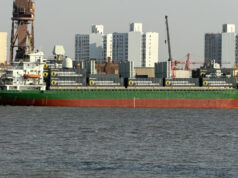Additional F-35B pilots have now ‘shifted on to night flying as they move closer to becoming carrier qualified’, say the Royal Navy.
HMS Queen Elizabeth recently sailed from her home port of Portsmouth to conduct training with UK F-35 Lightning jets in home waters.
Specifically, the ship is sailing to conduct Carrier Qualifications as well as Landing Signal Officer qualifications with 207 Squadron, the UK’s F-35 Lightning training squadron.
Our .@RoyalNavy and .@RoyalAirForce pilots have now earned their day sea wings.
Tonight the focus shifts on to night flying as they move closer to becoming carrier qualified.#NightVision #RoadToCSG21 #UKF35 #F35 pic.twitter.com/Mm2MburTqz
— HMS Queen Elizabeth (@HMSQNLZ) February 3, 2020
HMS Queen Elizabeth’s Commanding Officer, Captain Angus Essenhigh, said in a news release:
“It is a real honour for me to be taking HMS Queen Elizabeth to sea for the first time as her new Commanding Officer. This period at sea will build on the successes of the Westlant 19 deployment, providing a fantastic opportunity for the ship to further its generation towards carrier strike, and will train and qualify UK F-35 pilots in UK waters for the very first time.”
Lieutenant Commander Richard Turrell, Flight Deck Officer on HMS Queen Elizabeth, added:
“This is a fantastic opportunity to further integrate and qualify United Kingdom F-35 pilots, ground crews and aircraft on board HMS Queen Elizabeth in UK waters. My team are excited to get to sea and continue the development of our ship to air wing partnership throughout 2020 and beyond to deploying with full carrier strike capability in 2021.”
207 Squadron are flying aircraft to and from the decks, day and night from their base at RAF Marham. Six pilots, both Royal Navy and Royal Air Force, are carry out their aircraft carrier qualification in that time.
824 Naval Air Squadron personnel have also been honing their night flying & submarine hunting skills on HMS Queen Elizabeth. 824 Naval Air Squadron is based at RNAS Culdrose and is equipped with eight Merlin helicopters.














Will we be purchasing the external gun pod for the B? I know this compromises stealth and maybe a potential problem in relation to weight for vertical landings onboard the QE’s.
The F35 A still has some serious issues to sort out it appears.
Newer F-35As cracking due to gun use.
https://www.janes.com/article/94071/newer-f-35as-cracking-due-to-gun-use
Weight
102. The Times also suggested that the US documents have revealed that the initial F-35Bs purchased by the UK are too heavy to perform the vertical take-off and landing function safely:
100… when early versions were upgraded, they would be over the weight permitted for a safe landing. Britain bought four of the 14 aircraft affected, records suggest. The report estimates further upgrades, to bring the aircraft up to its full potential, would push it over an even stricter “structural limit”. Without the upgrade, the aircraft will miss out on future software and hardware updates.
103. The DOT&E report cited by The Times states that modifications to the 14 Lot 2 F35-
Bs, required to bring those aircraft to the Block 3F configuration, “are expected to bring
those aircraft to potentially an additional 350 pounds [in weight]”. This would push those
aircraft “above the objective not-to-exceed weight” to meet the vertical landing bring-back
(VLBB) key performance parameters.
104. According to the DOT&E report, estimates for the additional weight accrued from
follow-on-modernisation (FoM) to the Lot 2 F-35Bs include an extra 250lbs “which will
exceed the vertical landing structural limit not-to-exceed weight of 33,029 pounds for
the Lot 2 through Lot 4 aircraft”.
As mentioned in The Times, the report suggested that “this additional weight may prevent these aircraft from being upgraded to the Block 4 configuration”.
The slow rate of procurement by the UK seems to look better and better every time we here more about the early Lots…
I don’t see how early models could be over the weight for VL, the F35B can land with some munitions and fuel. Additional weight would be dumped before landing so this would means more weight would need to be dumped, but the UK is also developing SBRVL to reduce or eliminate this. I would think these earlier version are in the US and used mainly for training and will so far fewer VLs than those we deploy on the carriers. The extra weight is an issue but manageable as it appears confined to a limited number of airframes imo.
True, but can pilots carry out SBRVL in all weather conditions. I thought it was intimated that it would not always be feasible to use this method of landing, but would be preferred when possible?
I think the UK has some way to go in developing the parameters for SBRVL. If it becomes the norm then in really bad conditions if it could not be performed you dump fuel and stores and do the VL. I assume you only fly in poor conditions if we actually at war and under threat, with most likely case being task force protection which be a fairly light config apposed to a full strike config. From what I gather from the above there only 4 airframes impacted an these are early production lots so these could become dedicated for training and never deployed to the carriers meaning VL is never needed so manageable. Big disappoint is the F35 underwent a weight reduction exercise during development costing nearly 7b USD, now seems to be pilling the pounds back on.
“Newer” gun pods …” Shouldn’t it be “older” ones? Or is there a newer design.
Sounds like there will be three F-35s plus Merlin 2s and Junglies.
The Ford Class appears to be making some headway with EMALS.
Carrier Ford completes aircraft compatibility testing
”
Ford ACT included the following aircraft: T-45 Goshawk; E/A-18G Growler; E-2D Advanced Hawkeye; C-2A Greyhound; and F/A-18F Super Hornets.”
https://www.janes.com/article/94136/carrier-ford-completes-aircraft-compatibility-testing